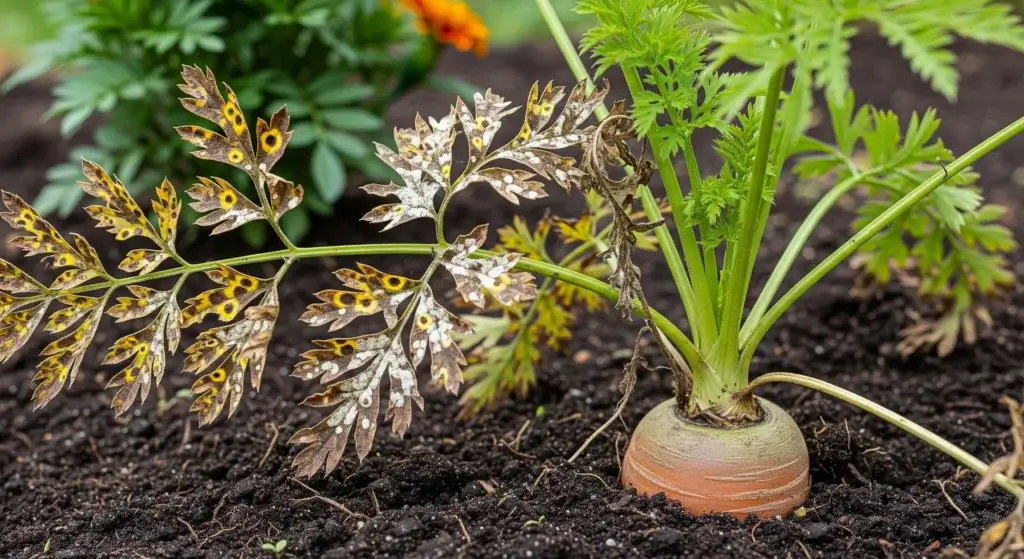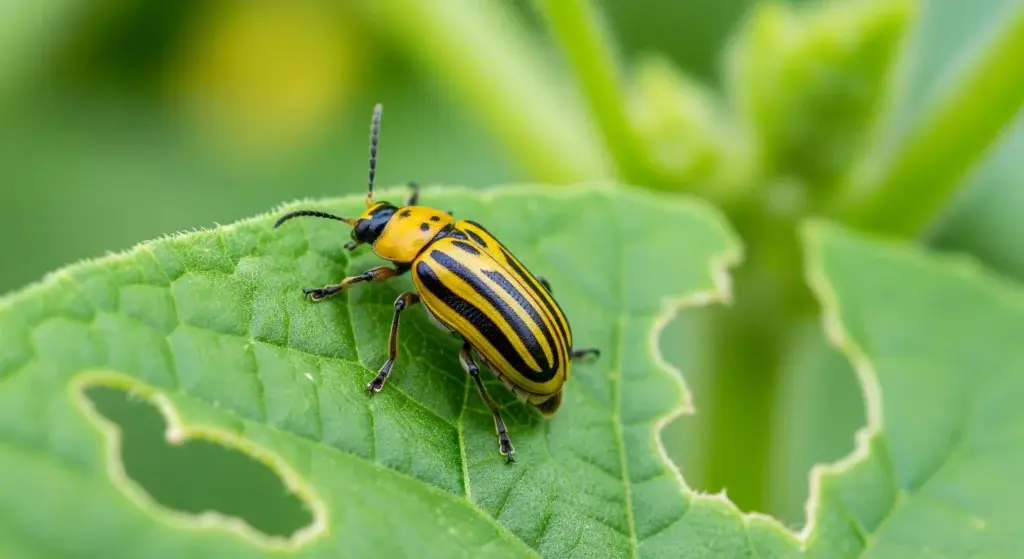Every gardener’s heart does a full-on dramatic flop when a perfectly happy squash plant suddenly keels over like it just lost the will to live. If this has happened to you, yeah… that’s probably the squash vine borer—basically the tiny garden villain that shows up uninvited and wrecks your harvest like it’s starring in its own disaster movie.

Understanding the Squash Vine Borer
Think of the squash vine borer as a tiny moth’s larval army that sneaks into your plants and turns them into floppy, sad shadows of themselves. The adults (which look weirdly like wasps — orange bellies with black dots and clear wings) fly in early summer and lay eggs on stems and leaves. When the eggs hatch, white caterpillars with brown heads bore straight into the stem and eat the inside — one grub can ruin a whole plant, and a few of them can wreck your patch fast. They love summer and winter squash, pumpkins, and gourds; cucumbers and melons, mercifully, are usually safe and make great backup plans or companions.
Identifying Squash Vine Borer Damage
Spotting squash vine borers early is basically the difference between “my garden is thriving” and “why does everything look like it rage-quit life overnight?” Here’s how you can tell these little chaos gremlins have moved in:
- Sudden wilting: One day your squash looks like it’s ready for a magazine cover, and the next it’s flopped over like it just got bad news.
- Frass near the base: Check the bottom of the stem. If you see what looks like weird greenish-yellow sawdust—yep, that’s frass.
- Entry holes: Tiny holes near the base of the stem are basically the borer’s front door. That’s where the baby caterpillar punched its way in like it pays rent.
- Hollow or damaged stems: Give the stem a gentle squeeze. If it feels squishy or hollow, it’s not having a glow-up; it’s being eaten from the inside.
- Yellowing leaves: As the plant struggles to move nutrients around, the leaves start turning yellow and sad, kind of like when you skip breakfast and try to function anyway.
Learning these signs now saves you from heartbreak later, and your plants will thank you by not collapsing in dramatic fashion.
Immediate Treatment Methods for Active Infestations
Once you spot squash vine borers, you’ve basically walked into the garden version of a medical drama. The good news? You can still save your plants if you act fast. Here’s how to go full “plant surgeon” mode without freaking out.
Physical Removal Through Stem Surgery
This sounds wild, but it’s honestly the MVP move. You’re basically doing tiny plant surgery.
Grab a sharp, clean knife or razor and carefully slice the stem lengthwise where you see the frass or holes. Inside, you’ll find the little white larva chilling like it owns the place—remove it by hand. It’s gross but ridiculously satisfying.
After the extraction, bury that injured part of the stem with moist soil so the plant can grow new roots and recover. If your plant looks a little wonky afterward, prop it up with a stake.
If you catch the problem early, most people save 70–80% of their plants. That’s a huge win for a procedure that feels like you’re role-playing a field medic.
Injection Treatment
If slicing open stems makes you feel like you’re committing plant crimes, there’s a less… surgical option.
You can inject Bt (Bacillus thuringiensis—basically a caterpillar-targeting bacteria) right into the entry holes with a syringe. It’s super specific, so it hits the borers without nuking everything else.
Follow the directions, usually applying in the evening, and be ready to repeat every 5–7 days. Think of it like giving your plant its antibiotics.
Beneficial Nematodes
These are microscopic worms that hunt down squash vine borer larvae like tiny soil ninjas.
Apply them around the plant base in early morning or evening, water well before and after, and keep the soil moist so the nematodes stay alive and ready for battle.
You’ll usually reapply every 7–10 days. It’s a chill method—like sending in reinforcements instead of going hand-to-hand combat.
Handling borers feels dramatic the first time, but once you nail these techniques, you’re basically unstoppable for future seasons.
Preventive Strategies for Long-Term Control
Stopping squash vine borers before they show up is way easier than trying to rescue a plant that’s already looking like it pulled an all-nighter and gave up. These strategies help you stay several steps ahead of the chaos.
Timing and Plant Selection
- Plant early or late: Adult borers roll up in early summer like they own the place. If you plant super early, your squash might be big and strong before the moths wake up.
- Choose resistant varieties: Butternuts, green striped cushaws, Dickinson pumpkins, and calabaza squash are way tougher and way less likely to get wrecked.
Physical Barriers
- Row covers: Throw on some lightweight floating row covers right after planting. It’s basically your squash wearing a tiny force field.
- Stem wrapping: Wrap the bottom 6–8 inches of the stem with foil, old stockings, or fabric strips. It’s like giving your squash a protective sleeve so moths can’t sneak in.
- Mulching: Add a fat layer of mulch around the base. It makes life harder for larvae trying to wiggle into the soil to pupate.
Cultural Practices
- Crop rotation: Don’t plant squash in the same spot every year. Rotate every 2–3 years so borers don’t get comfy and set up a family tree.
- Trapping adults: A yellow bowl of soapy water is weirdly effective. Moths are drawn to the color, dive in, and… well, they don’t dive back out.
- Regular monitoring: Check your plants every couple days during peak borer season. The eggs are tiny brown ovals that look like someone stuck pepper flakes to your stems.
- Companion planting: Some gardeners swear that smelly herbs like nasturtiums, marigolds, and tansy help repel the moths.
End-of-Season Management
- Destroy crop debris: After harvest, yank out all squash vines and trash them. If you leave them lying around, you’re basically providing winter apartments for next year’s borers.
- Till soil: A deep till in fall flips the soil and exposes hidden pupae to predators and rough weather. Consider it nature’s “delete” button.
Organic and Chemical Control Options
When things get super chaotic and the borers are basically throwing a party inside your squash stems, you might need to level up your strategy. Here’s how to handle the situation without going full apocalypse mode.
Organic Options
- Bacillus thuringiensis (Bt): This is a naturally occurring bacteria that only targets caterpillars, so it’s like sending in a squad that only fights the villains and leaves everyone else alone.
- Spinosad: This comes from soil bacteria too, but it’s a bit more heavy-duty. It’s still approved for organic gardening, and using it as a stem spray.
- Neem oil: This won’t do much once borers are inside the plant—they’re basically in a bunker at that point—but neem can discourage moths.
Chemical Controls
If you’ve tried everything and the borers are still clowning on your squash, synthetic options like permethrin or bifenthrin can step in. These should always be applied to the base of the plant, especially the stems, since that’s where moths love to drop their eggs.
Start treatment in early summer when adults show up, and keep it going weekly for 4–6 weeks. Always follow the product label to the letter—no freestyling.
Monitoring and Maintenance Throughout the Season
Keeping squash vine borers in check is kind of like keeping your room clean: if you let things slide for a week, chaos takes over. Staying on top of it makes everything way easier.
Weekly Tasks:
Check the base of your plants for frass, holes, or any plant that suddenly looks like it lost the will to live. Look for eggs on stems and leaves—tiny brown ovals—and flick them off ASAP. If you’re using Bt, this is when you reapply it. Adjust row covers when you need to let the pollinators in, then put them back if pest pressure gets wild.
Bi-weekly Tasks:
Bury parts of the vine where it naturally touches the soil so it can grow backup roots—basically giving your plant extra lives. Add fresh mulch to keep things neat and help block larvae. Check your traps and swap in new soapy water if you’ve collected a bug soup.
Monthly Tasks:
If you’re working with beneficial nematodes, reapply them so your soil army stays active. Take a good look at plant health and, if it’s early enough in the season, replace plants that look beyond saving. Keep track of pest activity so you’re smarter next year.
Creating a Comprehensive Management Plan
The best strategy is mixing a bunch of methods into one master plan—like a playlist where every song hits. Here’s what a solid approach looks like:
- Pre-season: Pick tougher squash varieties, plan your crop rotation, and get your row covers ready.
- Planting time: Plant early when you can, put those row covers on, and wrap the stems for protection.
- Early season: Watch for adult moths like a hawk, use preventive Bt, and check for eggs every day.
- Mid-season: Remove row covers for pollination, keep monitoring, and do plant surgery if it comes to that.
- Late season: Keep plants healthy, harvest on time, and start prepping for the big fall cleanup.
- Post-season: Pull up all squash debris, till the soil, and use your notes to plan a stronger game for next year.
Conclusion
Squash vine borers are annoying little chaos goblins, but they don’t get to decide whether your garden thrives. When you understand how they live, spot the signs early, and actually stay on top of your plants, you can totally beat them.
The real secret is catching stuff fast and checking your plants like they’re your pets sneaking snacks they shouldn’t have. And seriously—don’t be scared of stem surgery. It feels dramatic, but it saves way more plants than you’d expect.



